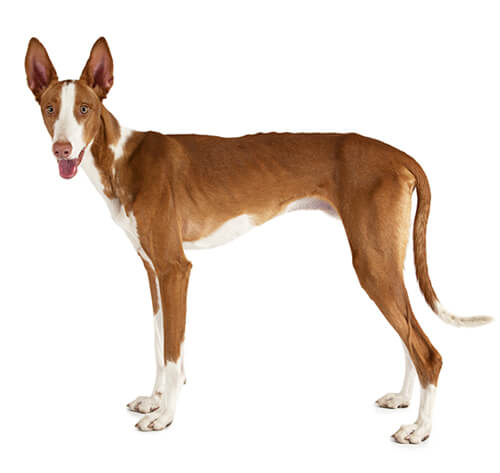
Characterized by his tall, lean body, long tail and large, upright ears, the Ibizan Hound is an elegant Egyptian sighthound bred to hunt rabbits. This athletic, agile breed is known for his ability to jump six feet in the air from a standstill. Alert, affectionate and loyal, the Ibizan Hound is suitable for families with children. These hounds require vigorous daily exercise in a sizeable high-fenced area.
DID YOU KNOW? In 1922, historians discovered King Tut’s tomb and found the life-size statue of Anubis, who was known as the “Watchdog of the Dead.” The statue was identical to the modern Ibizan Hound. The Ibizan Hound is named for the Spanish island of Ibiza, where the breed was brought over by Phoenician sea traders in 3400 B.C. to hunt rabbits for food
ALSO KNOWN AS: Ca Eivissenc, Podenco Ibicenco, Ibizan Warren Hound
The need-to-know
- Dog suitable for owners with some experience
- Some training required
- Enjoys active walks
- Enjoys walking an hour a day
- Large dog
- Minimum drool
- Requires grooming once a week
- Non hypoallergenic breed
- Quiet dog
- Not a guard dog
- May require training to live with other pets
- May require training to live with kids
Personality

This is a very affectionate, sensitive breed. They are wonderfully loyal and make a good pet in the right home. However, this is not a breed for the fainthearted: they can be fairly vocal and adore company – this is not a breed that can be left for long hours.
History and Origins

This breed is truly a living piece of history. The Ibizan Hound dog breed can trace its roots back to 4,000BC and beyond. Mostly associated with the time of the Great Pharaohs, the breed is depicted on many friezes, with the most notable icon being the Anubis. It would be true to say that the breed has not really changed in many thousands of years. Phoenician traders took the Ibizan Hound to the Balearic Islands, and to this day they can be found still working in Spain and its surrounding islands.
Nutrition and Feeding

Your dog's diet needs to have the right balance of all the main nutrient groups including a constant supply of fresh water. It's important to conduct regular body condition scores to ensure you keep your dog in ideal shape and remember to feed him at least twice daily and in accordance with the feeding guidelines of his particular food.
Exercise

These dogs require lots of exercise – a couple of hours daily for adults. Once on the scent of game, they will run and run, so a reliable recall is essential and they should be exercised in safe areas with no traffic risks or other dangers.
Other Information

Health and Common Issues
The Ibizan Hound dog breed is generally hardy with few widely recognised health problems. Some neurological conditions are reported but do not appear to be common.
Best Family Dog Breeds
While many dogs are traditionally thought of as being good with children, all dogs and children need to be taught to get on with and respect each other, and be safe together. Even so, dogs and young children should never be left alone together and adults should supervise all interactions between them.